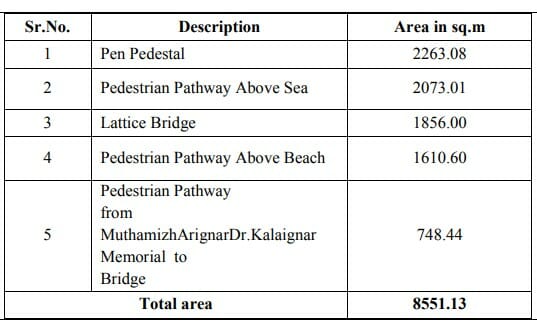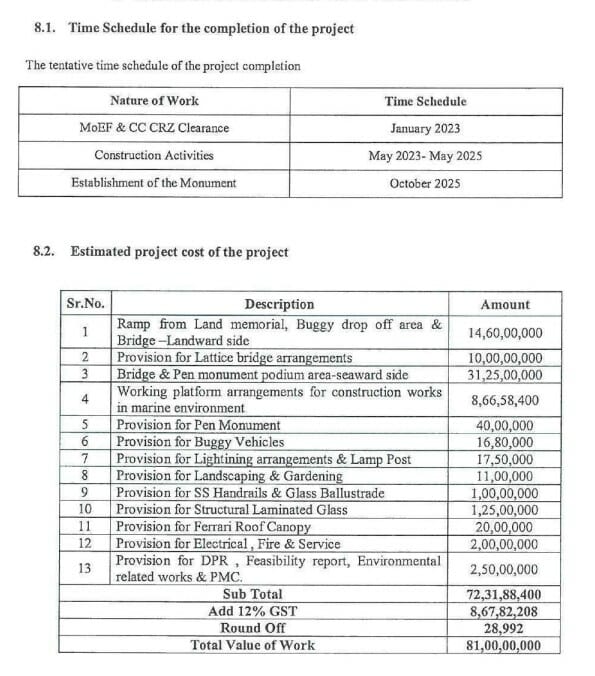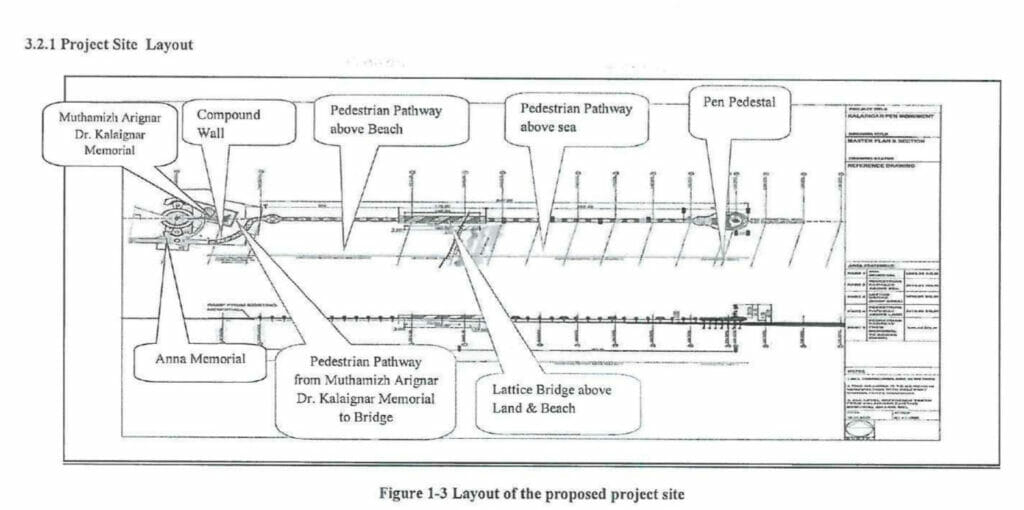A monument to pay tribute to former Chief Minister and DMK supremo M Karunanidhi for his contributions to Iyal, Isai, and Nadagam – the three pillars of Tamil language and literature – has evoked mixed reactions in the state.
The 134 feet tall ‘Muthamizh Arignar Dr Kalaignar Pen Monument’ is proposed to be built in the Bay of Bengal 360m off the Coast of Chennai’s Marina Beach near Triplicane.
The key opposition to this monument has hinged on its impact on the environment and marine ecology and the livelihood of fishing communities in Chennai.
Read more: Women of Ennore are living testimony to the many costs of pollution
What will make the Pen Monument in Chennai
The proposed construction of Pen Monument in Chennai will have the following components
- Pen Pedestal
- Pedestrian cum Glass Walkway
- Lattice Walkway
- Elevated Walkway
The pen monument is to be placed in the Bay of Bengal off the coast of Chennai’s Marina Beach at a distance of 360m from the shoreline in CRZ-IV (A) area, as per section 4(ii) (j) of CRZ Notification amended on March 22, 2016, for construction of memorials/ monuments and allied facilities by the concerned State.
While the PWD constructs and maintains all the state-owned government buildings of public and government utility, the proposed pen monument requires CRZ Clearance because it involves both onshore and offshore construction. It covers an area of about 8551.13sq.m (2.11 Acres). Therefore, it covers CRZ-IVA, CRZ IA & CRZ II.

The proposed project is planned to be executed at an estimated cost of Rs 81 crores.

While the Tamil Nadu Pollution Control Board has conducted the public hearing for the project, it will be followed by the state government submitting the Final Environmental Impact Assessment Report, Final Environmental Management Plan and Risk Assessment and Disaster Management Plan. This will be subject to clearance from the central government.
Public hearing for Pen Monument high on emotions
The Tamil Nadu Pollution Control Board conducted the public hearing for the proposed Pen Monument in Chennai on January 31. The hearing began at 10 am. While it was supposed to go on till the end of the day, the TNPCB officials closed the hearing at 1.30 pm. Of the hundreds of people gathered at the Kalaivanar Auditorium, only around 30 were allowed to voice their opinion.
The common sentiment among those in favour of the proposed project was that Kalaignar has brought in many welfare measures for the fishing community and they were indebted to him. They opined that by speaking up in favour of the Pen Monument in the sea, they were paying him a fitting tribute.
A fisherman from Nochikuppam, who expressed his opinion on the stage said, “We are giving our consent and in return we expect the government to fulfil the 40-year-long promise of providing housing for around 1,000 families in our fishing hamlet.”
A source from the fishing community said that the local politicians held a couple of rounds of talks before the public hearing with the fisherfolks where they promised to fulfil the promises made for each fishing hamlet in return for their cooperation for the Pen Monument project.
“They did not ask us to not voice our concerns in the public hearing but they asked us to not politicise the issue,” the source said.
Dr TD Babu, a Marine Biologist, who spoke at the public hearing, said, “It was not a public hearing at all but a party meeting. Most of them at the hall were party cadres from the ruling party and most of them who were given chance to speak were also only praising their leaders. This public hearing was driven by the party agenda and not the public agenda.”
A few groups who gathered for the public hearing also alleged that the local politicians paid from Rs 1,000 to Rs 1,500 per head and also arranged a van to bring them to the spot. Many of them were not even aware of what the meeting was about.
Prabhakaran Veeraarasu, Environmental Engineer at Poovulagin Nanbargal noted, “Those who opined against the project were not given sufficient time or space to speak. The officials also instructed me not to speak about anything controversial when I got on to the stage. The public hearing was not conducted democratically.”
Though the public hearing was to emphasize environmental concerns, it turned into a stage for expressing political allegiance.
Read more: Why fisherfolk in Chennai are opposed to beach beautification projects
Environmental concerns around the Pen Monument
Many who objected to the project at the public hearing and expressed their concerns about the coastal ecosystem were only opposed to the location of the monument in the sea as against the idea of having a monument for the leader.
“First of all having a burial ground at the beach itself is a blatant violation and degradation of the coastal habitat. The neritic zone (shallow marine environment extending from mean low water down to 200-metre depths, generally corresponding to the continental shelf) usually has a highly productive fishing area. While many factors contribute to it, the primary producers are very high here as the sunlight reaches the bottom of the sea. The construction of a concrete structure in the sea will prevent sunlight penetration thereby affecting the physiology of the marine organisms,” pointed out Babu.
Further, the Pen Monument is proposed to have illuminations during the night. “The physiology of all the organisms in the sea depends on the photoperiod (light period). The light pollution will affect the breeding and feeding behaviours of these organisms thereby disturbing the entire marine ecosystem,” Babu added.
The ‘Anticipated Environmental Impacts’ section of the project summary points out, “The major source of impact on marine water is sunlight and it may not penetrate the water resulting in reduced temperature. The temperature influences biochemical processes and deep channels may create a zone of poor conductivity that can serve as barriers to migration for the species living close to the bottom of the sea.”
However, there are no mitigation measures charted for this issue in the report.
While the EIA report states that no major aquatic life is being envisaged in the distance of 360 m from the shoreline, a representation objecting to the Pen Monument in Chennai made by Chennai Climate Action Group (CCAG), pointed out that the project area for the monument inside the sea is only 130m south of the Cooum estuary and serves as highly productive fishing grounds.
K Bharathi, President of the South Indian Fishermen’s Welfare Association, also noted that of the three fish production areas in Chennai (Cooum, Adyar and Ennore estuaries), one will be completely destroyed if the Pen Monument is set up.
“Despite the officials promising to not deny access for the fishermen to this part of the sea, we are sure that we will be denied access to the fishing zone. We have learnt this from our past experiences,” he said.
The monument would obliterate fishing grounds near the Cooum Estuary and destroy the livelihoods of fishers from at least 34 coastal villages.
The nature of the seabed at the project area are kadavadu seru, tharai, paaru (muddy, sandy or rocky, as in reef) which are highly biologically productive. Every monsoon fresh healthy sediment is rebuilt at the proposed project site that hosts fish including kelangan, keechan, nandu, naakku, udupa, udupaathi, kala, mathi, semakkera, thulra, por-ra, thirukkai, panangyan and vavval. Prawns and ribbon fish that are used as feed for deep-sea hook fishing are caught in these sediments too.
The proposed project site also falls in the coastal ecologically sensitive area/ CRZ IA in about 70m of ecologically sensitive turtle nesting area.
Issues with the EIA of the Pen Monument
Nityanand Jayaraman, an environmental activist who has written extensively on the environmental impact of the Pen Monument in Chennai, explained that the construction of memorials/ monuments in CRZ-IV (A) area, as per section 4(ii) (j) of CRZ Notification amended on March 22, 2016, is allowed only in exceptional cases.
In addition to the aforementioned environmental concerns, the EIA has not talked about the ocean current. For the most part of the year, the currents will be from north to south. With the establishment of the Pen Monument, there are chances of the assets (fishing nets and boats) of the fisherfolks getting damaged when they hit on the pillars of the Pen Monument. “This has not been accounted for in the EIA report,” noted Nityanand.
“Science requires the condition of integrity and honesty. This EIA lacks integrity and so any findings from the EIA cannot be relied upon as it does not pass the test of science,” he said.
Pointing out the contradictions in the EIA report, Prabhakaran said, “The first two chapters of the report say that the selected location is free of Olive Ridley sea turtle’s nesting area. On page 175 of the same report, it says that it is indeed the nesting area of sea turtles. The turtles choose the path based on the ocean currents and the establishment of the Pen Monument will definitely affect sea turtle nesting activities.”
Further questioning the integrity of the EIA, Prabhakaran said, the aim of the EIA is to assess the environmental impacts, socio-economic impacts and benefits of the project. “The weightage has to be given equally for all three factors. However, this EIA only concentrates on the benefits and so this has to be rejected,” he added.
Three alternative locations have to be chosen for the project. “The problem here is all three have been chosen inside the sea. While the first and third sites have been rejected citing that they fall under the eco-sensitive zones, the selected site, which is hardly 130 meters away from the first site, should also be rejected on the same basis,” Prabhakaran added.
“Be it the international reports on climate change or the Chennai Climate Action Plan released by the Greater Chennai Corporation, both have highlighted clearly that 100m of the coast is at risk of submersion as a result of 7cm of sea level rise in the next 5 years,” said Prabhakaran, adding that the EIA has not considered the impact of climate change.
Bharathi also pointed out that the EIA used rainfall data between 1970 and 2000. “While Chennai has received as much as 1044.33 mm in November 2022, page 133 of the EIA report states that the city has received 361.6 mm rainfall in November. How could 22-year-old data be used to account for the current environmental impacts?” he asked.
Courts the latest battleground
A Public Interest Litigation (PIL) has been filed at the Supreme Court challenging the Tamil Nadu government’s decision to construct the Pen Monument in the sea as it would damage the ecosystem and marine life in Marina Beach. A case has also been filed at the National Green Tribunal.
Very often when such structures of political importance are proposed, precedents are used to justify the act. In the case of the Pen Monument in Chennai, Chhatrapati Shivaji’s statue in Maharashtra was cited as a reference. However, while the emotion behind the establishment of such structures remains the same, it is pertinent to understand the difference in the nature of the environment.
Those opposed to the project question if the monument is the best way to pay tribute to the leader. “Kalaignar was fond of the libraries and known for setting up landmark libraries like Anna Centenary Library in Chennai. Had he been there now, would he have supported the Pen Monument in the sea?”, remarked an attendee at the public hearing.

Notwithstanding the likely environmental impact and the livelihood of fisherfolks, when the government is dithering on it poll promises citing paucity of funds, how can it justify spending Rs.81 cores on the pen monument? Further, what benefit does it give to the State and the people?
There seems to be not enough libraries in the north Chennai quarters. Due to environmental considerations why not leave the sea to the nature and allocate funds to build a memorial library similar to the Anna memorial library in the southern part.